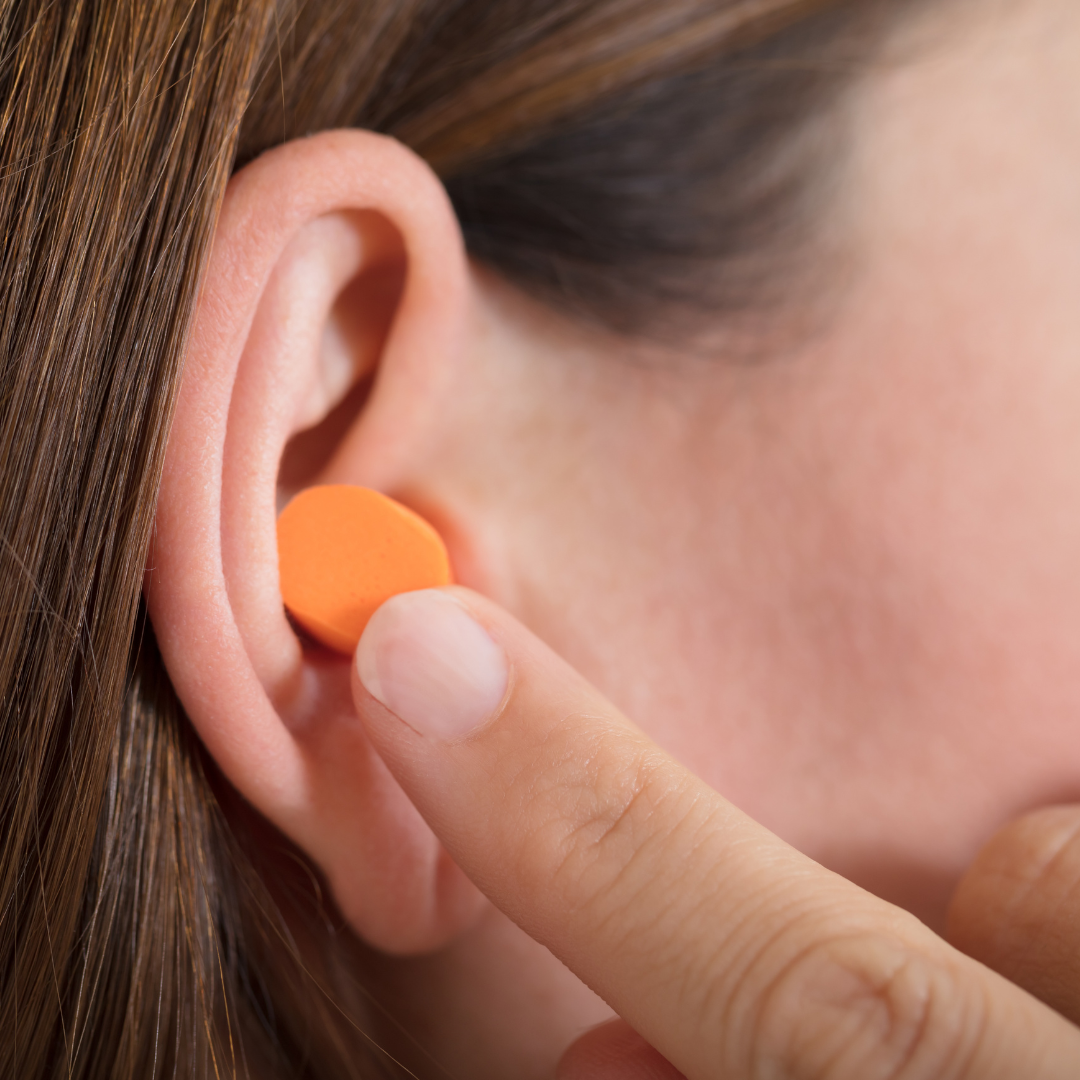
Silicone or Foam Earplugs? Choosing the Right Option for Your Hearing Protection Needs
Earplugs have many uses to protect your ears from noise and water. Have you noticed that you cannot hear well after a loud concert or a night in a club? That’s because loud noises can temporarily impair your hearing, and you can experience hearing loss with continued exposure. Protecting your ears with earplugs is critical for your hearing health.
Earplugs are also popular to protect your ears from water when swimming and can even help you sleep by muffling your partner’s snoring or traffic noises.
The best earplugs must be comfortable and seal your ears against external elements. When choosing the right earplugs, there are two popular materials: foam and silicone. There are advantages and disadvantages for both materials. In this post, we’ll walk you through both types of earplugs, their features and benefits so you can choose which may suit you best.
Silicone Earplugs: Features and Benefits
Most silicone earplugs are made of moldable silicone rubber, commonly known as silicone putty. Leading brands don’t contain latex to prevent allergic reactions. These earplugs are sold in the shape of putty balls you mould with your hands to fit your ear. These earplugs can be washed and reused, which makes them perfect for extended use.
Here are some of the benefits of using silicone earplugs:
- Comfort and ease of use
Silicone ear plugs adapt to any shape or size of the ear. These earplugs come in multiple sizes, are easy to use and comfortable. They are better for people who cannot have them because they sit in the ear opening instead of in the ear canal.
- Reusability and durability
Medical-grade silicone is reusable and washable. However, the earplugs must be changed if they don’t stick easily to the skin or are dirty with lint or dust.
- Hypoallergenic
The earplugs' silicone material is hypoallergenic and safe for sensitive people. Moreover, because they don’t contain latex, they are safe for people allergic to it.
- Ideal for swimming and water-related activities
Silicone is waterproof, which makes these earplugs the best choice for swimmers. They can effectively prevent bacteria, fungus, and swimmers’ ear build-up.
Best Uses for Silicone Earplugs
Silicone earplugs are more versatile and can be used in several scenarios than foam earplugs. However, their noise reduction capabilities are weak, so they perform better in moderately noisy environments.
Silicone earplugs are the better choice for:
- Swimming and water sports
- Active lifestyles
- People with ear canal sensitiveness
Steps for inserting and removing foam earplugs correctly

Image source : Mack
- Knead the earplugs between the thumb and forefinger until it is soft.
- Press the ball against the ear canal opening and push down until they seal it.
- Don’t insert it inside the ear canal! The earplug should cover the opening but not get inside the canal, as it can become lodged.
To remove it:
- Grab your ear lobe between your forefinger and thumb.
- Tug on it, pulling up and down several times, to dislodge the silicone in a single piece.
- Carefully remove the ear plug by grasping it from your ear.
Foam Earplugs: Features and Benefits
Foam earplugs are an inexpensive option for ear protection. They are mainly made from polyvinyl chloride (PVC) or polyurethane (PU), also known as memory foam. The earplugs are compressed and put inside the ear canal, where they usually expand to cause occlusion.
- Excellent noise-blocking properties
Foam earplugs are designed to seal your ear canal and block out noise. According to research, foam earplugs can reduce noise by 31 to 44 dB, making them more effective for construction workers and places with loud noises.
- Effective for sleep and snoring relief
Because it is inside the ear canal, foam ensures a tighter seal. The earplugs’ softness makes them very comfortable, even for sleeping. That’s why they are widely popular for sleeping.
- Disposable and hygienic
Foam cannot be cleaned thoroughly. That’s why these earplugs are usually disposable and sold in packages. Using disposable earplugs allows you to prevent bacteria build-up and ear infections. Foam earplugs are less expensive than silicone earplugs.

- Ideal for travelling and concerts
Foam earplugs are helpful for concerts, as they lower the decibels. However, regular foam earplugs tend to muffle the sound. Some foam high-fidelity earplugs provide better sound without compromising hearing protection.
Best Uses for Foam Earplugs
Foam earplugs are helpful for loud noise environments, such as factories, construction sites, concerts and clubs. They are porous, so they don’t protect against water. Foam earplugs excel at lowering noise from aeroplanes or for sleeping next to a snoring person.
Steps for inserting and removing foam earplugs correctly
- Wash your hands.
- Roll the earplug between your fingers until you get a thin, snake-like shape.
- Pull your ear up to open it a bit with your free hand.
- Insert the earplug inside the ear canal and hold it inside your ear for a few seconds while the foam unrolls and fills the ear canal.
Tips
- The earplug should be inserted inside the ear canal far enough to fit the ear canal but not too far enough to cause injury. See the image below.
- If a part of the earplug is showing, then it’s not correctly inserted.
- If the earplug is not blocking noise, try a larger earplug.
- If the earplug is painful, try a smaller size.

Right and wrong way to put in foam earplugs (Image Source)
Comparison between Silicone and Foam Earplugs
- Noise reduction ratings (NRR) comparison
Silicone earplugs block a fair amount of noise, with an NRR of 22-23 dB, which makes them a good alternative for environments with moderate noise, like travelling.
Foam earplugs, on the other hand, when inserted correctly, have a noise reduction rating of 28-33 dB, with some brands going up to 44 dB. These earplugs are more effective at blocking low-frequency noises, like traffic rumble, the noise of a generator or air conditioner, or a train engine.
- Comfort and fit comparison
Silicone putty earplugs can adapt to the shape of your ear canal. To apply them, the user moulds them with their hand, forms a ball and presses against the ear opening, flattening the ball. Pull your ear up while pressing in the ear to release the air trapped in the earplug. Because they don’t go deep into the ear canal, silicone earplugs are more comfortable for users who cannot tolerate other types of earplugs inside the ear.
Foam earplugs can be comfortable, depending on their insertion. You need some skill to insert them properly because they must be inserted deep into the ear canal. Some users simply cannot tolerate the feeling of foam inside their ears for a long time. Users may experience a feeling of pressure, itching, or simple pain.
- Reusability vs disposability
Silicone earplugs have the advantage of being washable and reusable. As long as the silicone is not dirty or stuck with dirt or lint, then it can be reused. This characteristic makes them more practical for regular users.
Foam earplugs are usually disposable. While there are some reusable models, most foam earplugs are disposable. This characteristic makes them very convenient for work settings.
- Cost-effectiveness and value for money
Foam earplugs are typically inexpensive and come in multiple shapes and sizes, while silicone putty earplugs are more expensive.
What if I’m allergic to silicone or foam earplugs?
Silicone earplugs may have colourants that can cause allergic reactions such as contact dermatitis. Some individuals can be allergic to foam earplugs, mostly because of bacterial growth or irritation due to sweat.
Wax doesn’t trap allergens in the material, making it an excellent option for sensitive individuals. Wax earplugs are also a good choice because of their malleability.
How to Choose the Right Earplugs for Your Needs
With all the variety of earplugs in the market, you may need help to choose which ones you should use for your needs. Here are three tips:
- Identify your lifestyle and work requirements. For instance, earplugs for swimmers differ from earplugs for construction sites or sleep comfort. Consider also if the noise exposure is constant or only appears at certain times of the day. Earplugs are not easy to remove, so they are better suited to environments with constant or almost continuous noise.
- Know the level of noise reduction you need. Most construction sites have a noise level of less than 95 dB. That means that most workers need only to reduce the sound to achieve the recommended exposure limit of 85 dB. However, the louder the environment, the more noise reduction you need.
- Evaluate what’s your level of comfort. Now that you know what type of earplugs fit your lifestyle and noise requirements, think about what is comfortable for you. Some people find foam earplugs very comfortable, while others cannot stand anything in the ear canal. Think also if you prefer disposable or reusable earplugs.
Maintenance and Care for Silicone and Foam Earplugs
How to clean your earplugs? It will depend on their composition. You can wash your reusable earplugs in warm water, hydrogen peroxide, or mild soap. Don’t try to clean them with any alcohol-based cleaner.
Customer Reviews and Rating Comparison:
We gathered positive and negative feedback from popular sites like Amazon on users of foam and silicone earplugs users.
Silicone Earplugs
Pros
- “These are a GODSEND. If I didn't already know what kind of sound was surrounding me, then I wouldn't know what kind of sound was surrounding me! :) They dull down construction noise immensely and even help with snoring noise to some degree.”
- “They conform to your ears easily, and they aren't sticky. I also take them on vacations with me, not just because my husband is a noisy sleeper, but all of the noise in and around the hotels.”
Cons
- “Better than foam plugs from a noise block standpoint. That said, I had to combine these with a white noise machine to block the snores of my spouse.”
- “Can still hear sounds too clearly with these earplugs. Would not repurchase it.”
Foam Earplugs
Pros
- “Earplugs are the best I've used so far, but I have been having a bad sleep because of my spouse snoring. I bought a pack of earplugs at a local drugstore, but it was hard and hurt my ears. Choose these because of the "35dcb and soft "mentioned in the ad. These earplugs are very soft and comfortable. It does not cancel the noise completely ( like if you were a deaf person and cannot hear anything), but it reduces noise to maybe 95% or even more.”
- “These plugs are absolutely the best I have ever worn. The shape keeps them in my ears the ENTIRE night's sleep! It cancels like 95% of the noise.”
Cons
- “Definitely not the db claimed. I can still hear a lot of conversation. I use them to sleep, and they do not block enough sound.”
- “They are not that great for blocking out noise and tend to fall out of my ears at night. Still better to have some noise blocking than none.”
It’s a wrap!
In this article, we discussed the pros and cons, features and benefits of the most popular types of earplugs: foam and silicone.
Foam earplugs are disposable, inexpensive and easy to use (after some training).
On the other hand, silicone putty earplugs are suitable for environments exposed to water, such as swimming and water sports.
The best way to ensure you adequately protect your hearing is to contact an expert audiologist.
Book a free online meeting today and get personalised recommendations.

Leave a comment
This site is protected by hCaptcha and the hCaptcha Privacy Policy and Terms of Service apply.